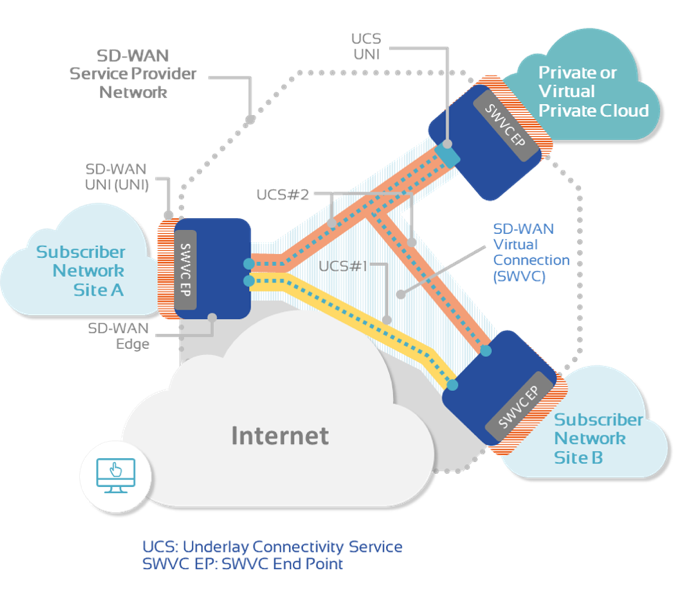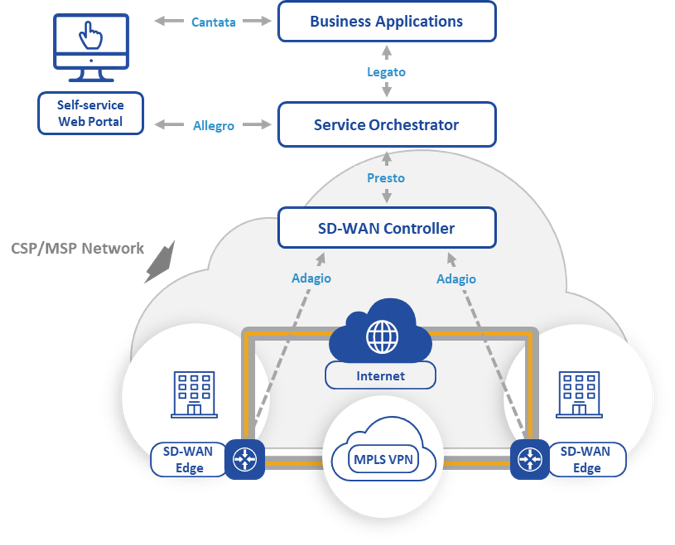
While SD-WAN has experienced rapid growth — and hype — the market has quickly fragmented with service providers and vendors alike offering a plethora of products and services. The result has been a proliferation of disjointed solutions resulting in confusion, lock-in, and a lack of interoperability.
Adoption has been driven by migration to the cloud and a compelling value proposition that exploits application-based policies, built-in security, and consolidated management. SD-WAN enables enterprises to exploit all available WAN connections to achieve application-based QoS, flow-based security, and cost reduction by offloading traffic to the internet wherever possible.
Responding to the rapidly changing market, MEF sensed a major opportunity, and introduced the first SD-WAN services standard (MEF 70). Late in May, MEF released the initial draft SD-WAN services standard, containing additional SD-WAN activities and deliverables planned for the remainder of CY 2019.
In this article, we examine the MEF SD-WAN standard, including the motivation, technical approach, project plans, and what we can expect in the future.
Why an SD-WAN Standard (and Why Now)?
For the past two years, MEF has been evolving its standards portfolio from Carrier Ethernet, the technology it created back in the early 2000s, to address virtualized services ushered in by SDN, NFV, and automation.
In 2017, complementing work underway in other standards and open source organizations, MEF introduced the MEF 3.0 framework for orchestrated and assured services. As literally dozens of vendors and managed services emerged, member organizations turned to the MEF to instill order, and MEF responded by creating the SD-WAN Standard program.
MEF’s strong service provider heritage — close to two-thirds of MEF members are operators — resulted in the formation of the SD-WAN program in 2018. Large operators were seeking to satisfy the needs of their enterprise customers while achieving multi-vendor interoperability, which is a must considering the complex organizations typical in large enterprises, where many service provider and vendor relationships are already in place — and not likely to be displaced.
The sense of urgency rose, as vendor claims for SD-WAN conformance escalated, along with end-user confusion. MEF intended to restore order by leveraging its global base of operators to fill the gap by offering a common definition, and comprehensive technology program focused on adoption.

Figure 1. MEF SD-WAN service framework
Source: MEF 70 draft standard
What is the MEF SD-WAN Services Standard?
The MEF SD-WAN service standard specifies an end-to-end, Layer 3 overlay that resides upon diverse underlay WAN services, as illustrated in Figure 1. Application-layer policies govern path selection and control. The control plane is provided by an SD-WAN controller — a form of an SDN controller — providing configuration at the SD-WAN service endpoints. By logically centralizing control, the SD-WAN controller maintains domain-wide visibility and enables more intelligent operations.
MEF 70 adopts a subscriber/service provider model and specifies the service attributes exchanged over the SD-WAN User-to-Network interface. MEF has defined extensive and precise terminology that collectively forms a common service definition, along with a framework for the service interactions across the overlay as well as the relationship to the underlays.
Policies may be applied to application flows, and/or application flow groups. For example, an application flow may be a particular video conference, while a flow group comprises all video services, including e-learning, marketing videos, and video chat that share similar traffic characteristics. As a result, video services may be assigned a low-latency or high-performance policy to ensure such services are fulfilled prior to non-performance-sensitive traffic.
MEF has defined a number of policies in the draft standard that address QoS, security, cost, etc. However, not all are required, nor do all underlays support all policies. As the standard evolves, additional policies are anticipated to enable more sophisticated value-added services.

Figure 2. MEF hybrid WAN use case
Source: MEF 70 draft standard
The predominant MEF SD-WAN use case is referred to as hybrid WAN, where traffic is partitioned among relatively expensive fixed and mobile services, e.g., MPLS, LTE, etc., along with the internet (refer to figure 2). While reducing expenditures on expensive fixed or wireless services is clearly a motivation, the primary goal is to make available capacity for performance-sensitive application traffic on-demand.
MEF SD-WAN Standard Status
To date, MEF has been focusing on the introduction of the MEF 70 standard, which recently approved the public release of the draft standard in May. Already underway is an effort to assess and prioritize the functionality in the next version, referred to as MEF 70.1. While there are a number of features requests proposed, among the priorities for the next release of the standard are the service activation and assurance requirements. Final decisions are expected by the autumn, 2019, for a release targeted in the 1H 2020.
Another activity deemed essential to the success of the standard — and vital for adoption — are the MEF SD-WAN Certification Programs. MEF is exploring both a technical certification and a professional certification program.
Both have been important to the success attained for Carrier Ethernet, so it is not surprising that MEF borrowed both pages from the Carrier Ethernet playbook to ensure SD-WAN success.
Details have not yet been announced for either program but are expected between now and the end of CY 2019.
Closing Thoughts
Traditionally, telecommunications standards help drive new technology initiatives. SD-WAN is markedly different, not just because SD-WAN is an enterprise-driven initiative, but also because SD-WAN is the first of many dynamic, software-centric services that necessitate a revamping of the technology adoption lifecycle. Implementations are an essential element to validating standards, which in turn drive standardized APIs and frameworks that can be readily adopted into the software development process.
It is precisely because the SD-WAN train has left the station that necessitates SD-WAN standardization. Both enterprises and service providers require multi-vendor/multi-operator services to attain the agility and automation that is envisioned.
The MEF SD-WAN standard is the industry’s first, but certainly not the last considering the anticipated growth. In particular, we believe the MEF’s SD-WAN standard will fuel the rapidly growing managed services segment, which will mature beyond “any SD-WAN product the enterprise desires” to a more conventional offering. As implementations converge, interoperability considerations will become front and center.
On the horizon are a number of enhancements, but perhaps most importantly, a security model for operators. In my next post, we will dig deeper into the MEF SD-WAN technical approach, and after that, SD-WAN security, so stay tuned.
